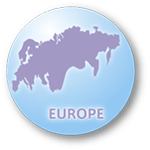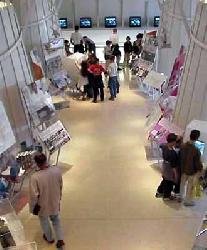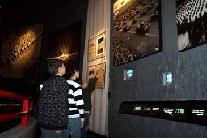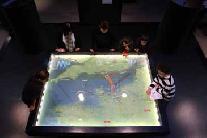EUROPE
Caen Memorial For Peace (France)
(Jan. 13, 2009)
by Christophe Bouillet, Historian, Cultural Department
Inaugurated on June 6, 1988 by Francois Mitterrand, Le Memorial de Caen is a major modern museum dedicated to the history of the 20th Century. Its innovative and emotionally charged presentation invites visitors to take a journey through history and a consideration of the planet’s future in three museum spaces: the Second World War, the Cold War, and the theme of Peace.
Le Memorial de Caen stirs visitors to consider the fragility of peace and human rights. One of the first memory sites in Europe, the museum welcomes nearly 400,000 visitors per year. With over 150,000 schoolchildren--50% of its visitors are young people under 20 years old--the Caen Memorial has developed an educational policy offering training courses for teachers, activities for classes, and educational documents for all academic levels.
The Second World War
Evoked by a great descending spiral, this first space starts in 1918, at the end of the First World War, and culminates in 1939. It recalls the sequence of events leading to the Second World War. The visitor gradually moves down past enormous photos of Nuremberg and hears the voice of Hitler, the mood becoming increasingly oppressive.
The second space grows darker, inviting the visitor to plunge into the atmosphere of the occupation years. Photos, posters, objects, and reconstructions (the wall of a French town covered with graffiti and propaganda posters) retrace the daily life of the French, collaboration, resistance, repression, and deportation.
The tone changes in the third space, which is a large, well-lit area divided into thematic locations. Intended to evoke the inside of a factory entirely consecrated to the war effort, it presents both the planetary character of the Second World War, with the presentation of the Eastern Front and especially the history of Stalingrad and Leningrad, and also the total involvement of nations, the military, and civilians.
The temporary long-term exhibition “D-Day Words” invites the visitor to discover the daily lives of the soldiers in the two camps during the Invasion and the Battle of Normandy. Drawing on soldiers’ letters and diaries written during the events and illustrated with photos, films, and objects, the Caen Memorial presents an alternative history of the D-Day Landings.
Beyond the fighting and battle, these are accounts of moments of respite, in which individuals tell of snatched moments of happiness, their suffering, and their anxieties. An exhibition, in the very spirit of the Caen Memorial, which spotlights man confronted with war.
The World and the Cold War
Composed of a series of symbolic interlocking gears featuring photographs and debris from the U2 spy-plane shot down in 1962 (the Cuban Missile Crisis), this skillful presentation highlights the key dates and protagonists of the Cold War.
A full-size Soviet MIG-21, a French nuclear missile from the Albion plateau, and an American atomic bomb bear witness to the frantic nature of the arms race in general and the race for nuclear weapons in particular. A veritable balance of terror was established between the two blocs. As they faced each other down, rivalries fed by dreams of conquest took shape: Expanding Spheres of Influence, One-upmanship and Space Leadership.
Objects and documents demonstrate the attempts other countries made to emancipate themselves from this East-West confrontation and to develop through Nonalignment, the End of the Colonial Period, The People’s Republic of China, and the Construction of Europe.
Here stand two sections of the Berlin Wall, with graffiti on the Eastern side to show “The Cold War is Over.” Beside them, seven dominoes recall the key dates of the 1980s: the free union Solidarity’s founding in Poland, Gorbachev’s launch of Perestroika, the overthrow of Ceaucescu in Romania, the Abortive Coup by conservatives in Moscow, and others.
Worlds for Peace
Another space, with large windows to the outdoors, provides a journey through the different Peace Cultures of the World, providing visitors with concrete tools on building peace from displays involving artifacts, documents, and photos.
A space dedicated to “Peace and Violence: The History of Racism” recalls that peace is not only the absence of war, but more broadly the absence of all kinds of violence.
Le Memorial de Caen has received several awards for its quality of reception and the wealth and quality of its content and offers several packages including guided tours. The museum also keeps abreast of current affairs worldwide and regularly organizes events open to all, such as the International Meetings for the Prevention of Conflicts, the Current Affairs Symposium, the Counsel’s Speech Competition in Defense of Human Rights, and debates.
Address: Esplanade Eisenhower - BP 55026 14050 Caen Cedex 4 France
Phone: +33-2-31-06-06-44
Homepage: http://www.memorial-caen.fr
Days closed: January 2009: 1st and 4th-26th
Admission: full rate: 15.50-16 euros; reduced rate: 14.50-15 euros; other discounts available
(Originally published on December 22, 2008)
 Peace Museums of EUROPE
Peace Museums of EUROPE



